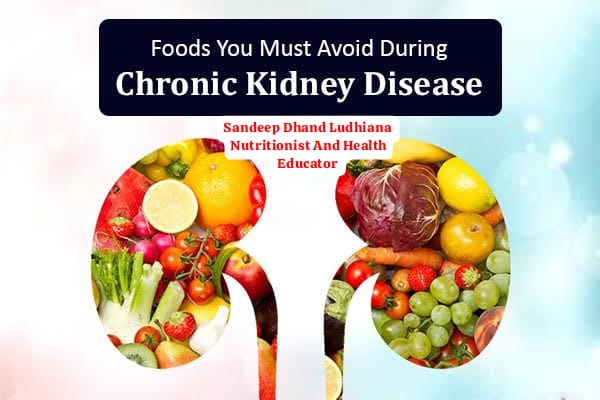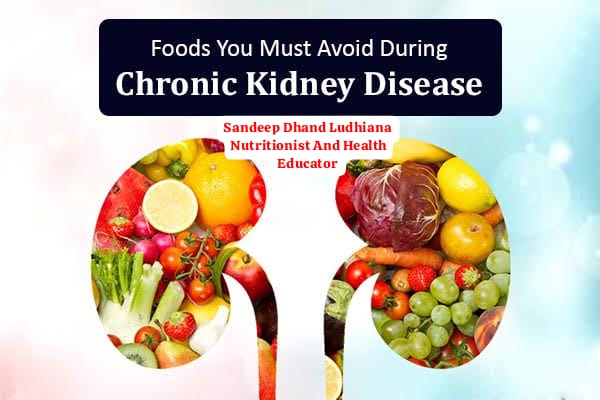Sandeep Dhand Ludhiana
Nutritionist And Health Educator
Chronic Kidney Disease (CKD) is a condition characterized by the gradual loss of kidney function over time. The kidneys play a vital role in filtering waste, toxins, and excess fluids from the blood. In CKD, the kidneys lose this ability, which can lead to a build-up of harmful substances in the body. Diet plays a crucial role in managing CKD by reducing the strain on the kidneys and maintaining overall health. Here’s a detailed guide to understanding and implementing a CKD diet.

- Importance of a CKD Diet
A tailored diet helps slow the progression of CKD, prevent complications like fluid retention, electrolyte imbalances, and high blood pressure, and improve the patient’s quality of life. Since CKD affects individuals differently, a diet plan must be customized based on the stage of the disease, overall health, and lab results like potassium, sodium, and phosphorus levels.
- Key Components of a CKD Diet
A. Protein Management
Why?
The kidneys filter waste products from protein metabolism. In CKD, excess protein can burden the kidneys and worsen the condition.
Guidelines:
In early to moderate stages (stages 1–3), reduce protein intake while ensuring adequate nutrition.
High-quality protein sources such as lean meats, poultry, fish, eggs, and dairy are recommended in limited amounts.
In advanced stages or dialysis, protein needs may increase to compensate for the protein lost during dialysis. Consult a dietitian for specific recommendations.
B. Sodium Control
Why?
Excess sodium can cause fluid retention, high blood pressure, and swelling, all of which stress the kidneys.

Guidelines:
Limit sodium intake to 1,500–2,000 mg per day.
Avoid processed and packaged foods like chips, canned soups, frozen meals, and salty snacks.
Use herbs, spices, and lemon juice for flavor instead of salt.
C. Potassium Regulation
Why?
High potassium levels (hyperkalemia) can lead to heart problems, while low levels (hypokalemia) can cause muscle weakness. CKD patients often need to balance potassium intake based on their lab results.
Guidelines:
Low potassium foods: Apples, berries, grapes, cauliflower, and rice.
High potassium foods to limit/avoid: Bananas, oranges, potatoes, spinach, and tomatoes.
Cooking methods like boiling can help reduce potassium content in vegetables.
D. Phosphorus Control
Why?
Damaged kidneys struggle to remove phosphorus, leading to high levels in the blood, which can weaken bones and cause cardiovascular problems.
Guidelines:
Limit phosphorus-rich foods such as dairy products, nuts, seeds, cola, and processed meats.
Choose alternatives like rice milk, fresh fruits, and vegetables.
Check food labels for additives like “phos-” (e.g., phosphorus-containing preservatives).
E. Fluid Intake
Why?
CKD can lead to fluid retention, causing swelling and difficulty breathing. Fluid needs vary depending on the stage of CKD and whether the patient is on dialysis.
Guidelines:
Track daily fluid intake, including water, tea, soups, and ice cubes.
Limit high-water-content foods like watermelon if advised.
Monitor for signs of fluid overload, such as swelling or weight gain.
- Foods to Include and Avoid
Foods to Include:
Low-potassium fruits and vegetables: Apples, berries, cabbage, and green beans.
Whole grains (in moderation): White rice, pasta, and bread (lower in phosphorus and potassium than whole grains).
Lean proteins (as recommended): Chicken, fish, egg whites.
Healthy fats: Olive oil, avocado (if potassium levels are controlled), and unsalted nuts (limited).
Foods to Avoid:
Processed foods: Chips, canned soups, fast food, and frozen meals.
High-potassium foods: Bananas, potatoes, avocados (if potassium is high).
High-phosphorus foods: Cheese, nuts, chocolate, and cola.
Salt substitutes: Many contain potassium chloride and should be avoided unless approved by a doctor.
- Special Considerations for Dialysis Patients
Dialysis patients have unique dietary needs because the treatment removes waste and some nutrients from the body.
Protein: Increase intake to replenish protein lost during dialysis.
Potassium and phosphorus: These levels may fluctuate; adhere strictly to recommendations.
Fluid: Strict monitoring is essential to prevent fluid overload.
- Tips for Following a CKD Diet
Work with a dietitian: A renal dietitian can create a personalized plan based on lab results and preferences.
Read labels: Check for sodium, phosphorus, and potassium content.
Plan meals: Prepare balanced meals and snacks to avoid last-minute unhealthy choices.
Stay hydrated carefully: Follow prescribed fluid limits and monitor symptoms.
- Common Challenges and Solutions
A. Limited Food Choices
Many CKD patients feel restricted by dietary limitations. Experimenting with herbs, spices, and new recipes can make meals enjoyable.
B. Dining Out
When eating out, ask for low-sodium options and avoid sauces, soups, or gravies.
C. Adapting to Changes
Lab results may necessitate frequent dietary adjustments. Stay informed and adaptable.
- Psychological Support
Dietary changes can be overwhelming, especially for long-term CKD management. Support from family, friends, and healthcare professionals can help. Joining CKD support groups or seeking counseling may also be beneficial.
- Conclusion
A well-planned CKD diet is essential for managing the disease, improving symptoms, and enhancing the quality of life. While dietary restrictions may seem daunting, with the right guidance and support, it is possible to enjoy a varied and nutritious diet. Always consult a healthcare provider or renal dietitian for tailored advice, as each patient’s needs are unique.
